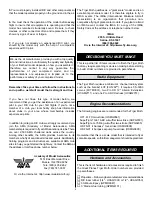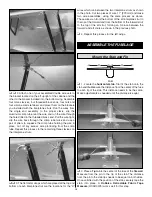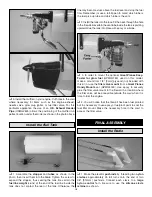
❏
2. Slide the pushrods into the
guide tubes
at the aft end
of the fuse. Slightly bend the pushrods as necessary so the
clevises will fit on the control horns. Carefully locate the
control horn with the hinge line as shown in the sketch. Drill
3/32" (2.4mm) holes through the
elevators
and then harden
the area with thin CA. Mount the horns with 2-56 X 5/8"
screws and the
nylon mounting plates
on the other side of
the control horn.
❏
3. Make the rudder pushrod by threading a nylon clevis
approximately 25 full turns onto the end of a 36" [914mm]
pushrod. Connect the clevis to a large nylon control horn. Be
sure to use the silicone clevis retainer as shown.
❏
4. Slide the pushrod into the guide tube at the aft end of the
fuse. Bend the pushrod as necessary so the control horn will fit
on the rudder and clear the horizontal stabilizer. Position the
control horn in a location that will not interfere with the elevator
movement. Drill 3/32" [2.4mm] holes through the rudder and
harden the area with CA. Mount the horn with 2-56 x 3/4"
[19mm] socket head cap screws and the nylon mounting plate
on the other side of the control horn.
❏
5. Install the
rubber grommets
and
brass eyelets
in the
servos using the above sketch as a guide.
❏
6. Cut off three arms from three servo horns included with
your radio control set to make them into
“one arm”
servo
horns. Use an
Easy-Touch Bar Sander
(GPMR6170) to
remove the remaining jagged edges left from the cut-off arms.
❏
7. Install the rudder servo by marking its location and drill
1/16" [1.5mm] pilot holes through each mark. Harden the
areas with thin CA. Mount the servo with the screws
provided with your radio system.
❏
8. Center the rudder servo and mark the pushrod where
it crosses the servo arm. Enlarge the servo horn hole with a
5/64" [2mm] drill bit.
❏
9. Make a 90-degree bend in the pushrod on your mark
and cut the pushrod off 1/2" [13mm] beyond the bend. Insert
the wire through the enlarged hole in the servo arm. Secure
the wire in place with a
nylon FasLink pushrod keeper
.
FasLink
2-56 (.074") Pushrod Wire
Servo Horn
Cut Off
Unused
Arms
Correct
Incorrect
17












































